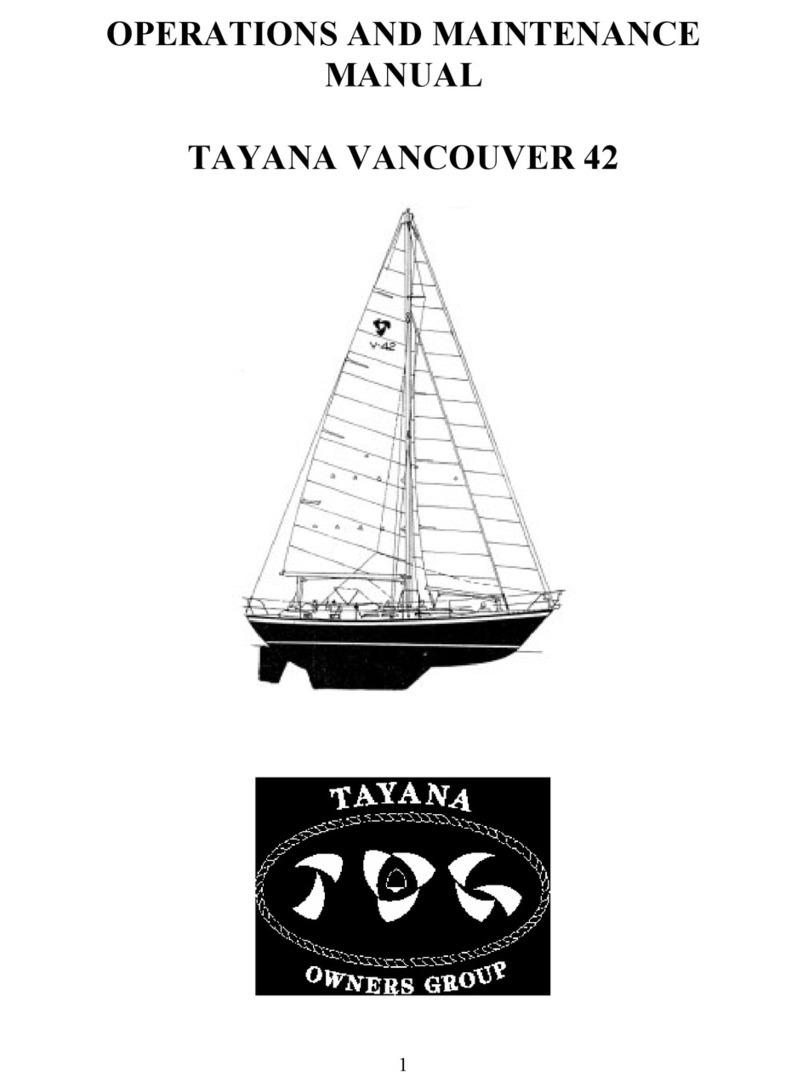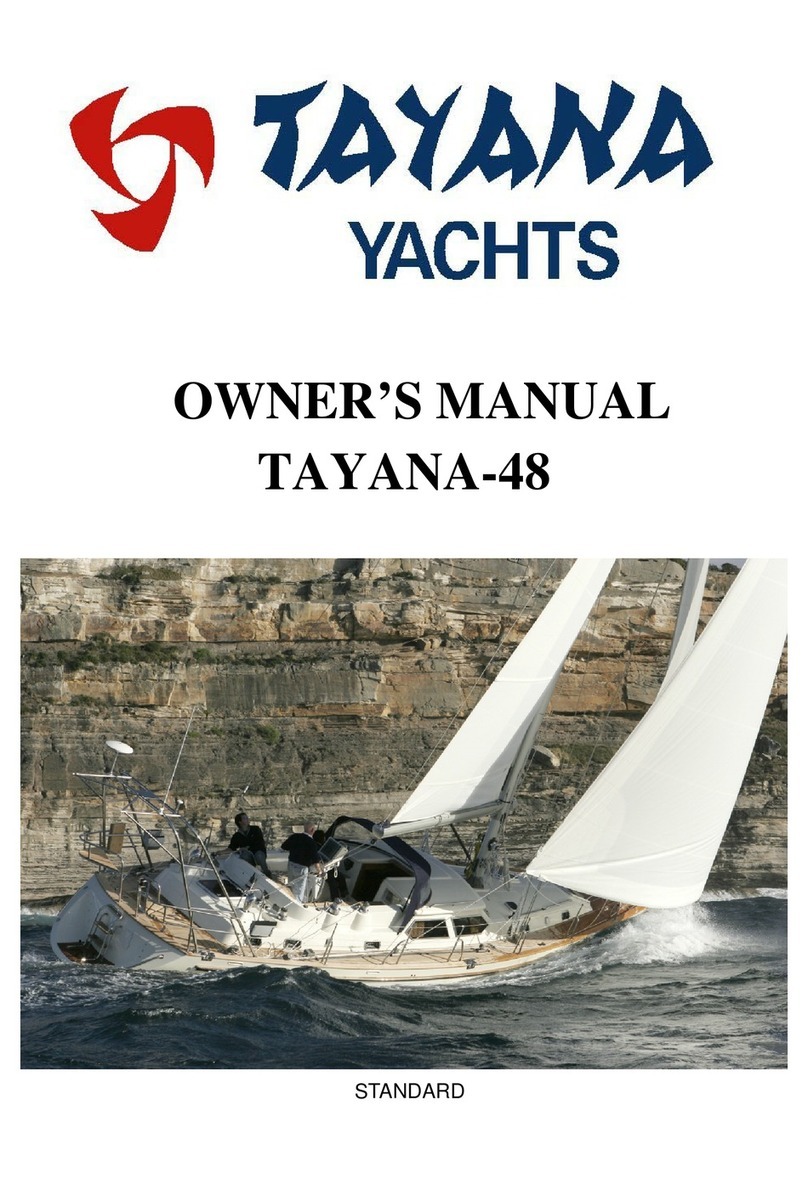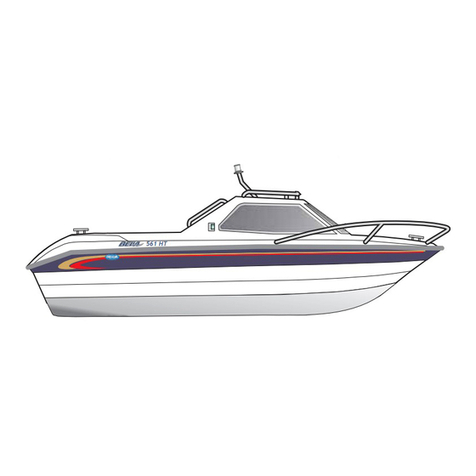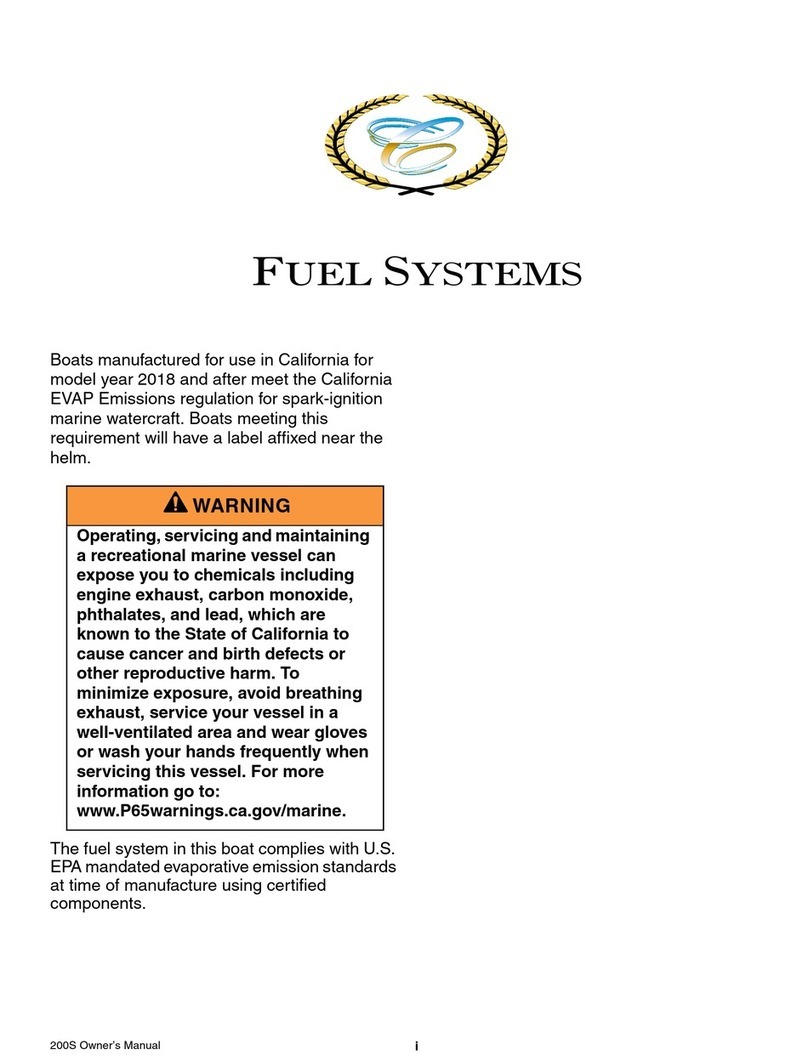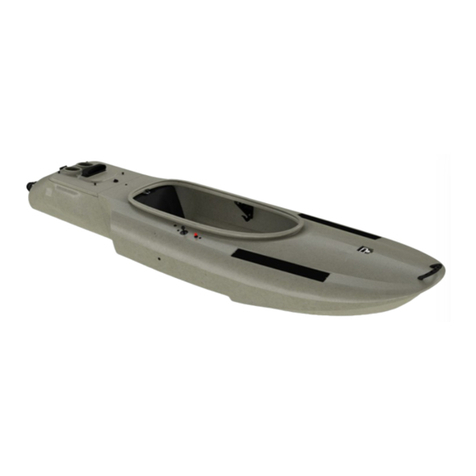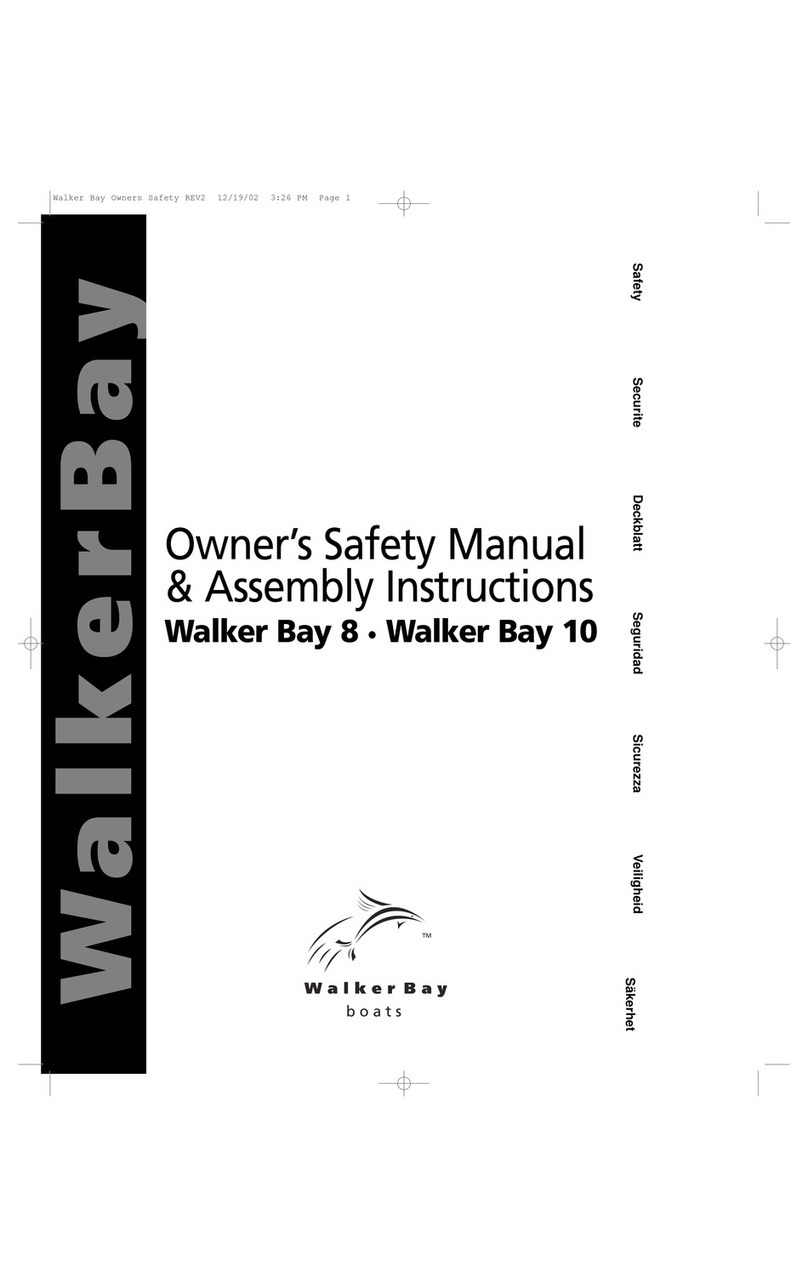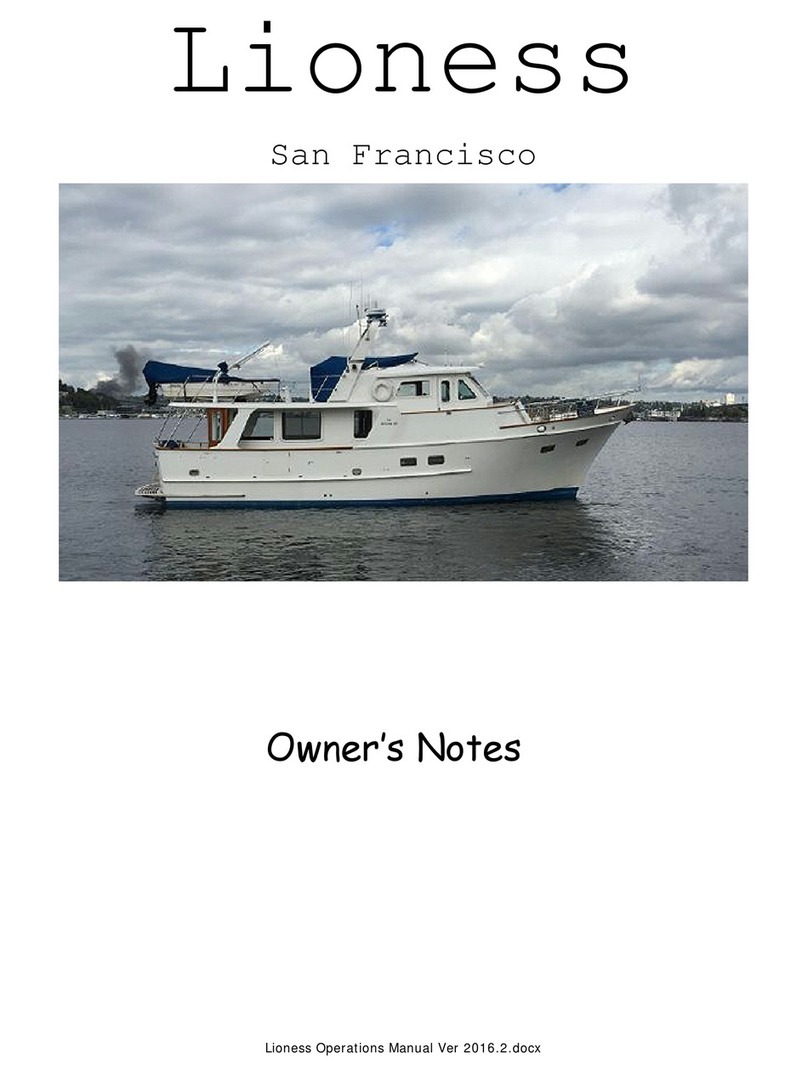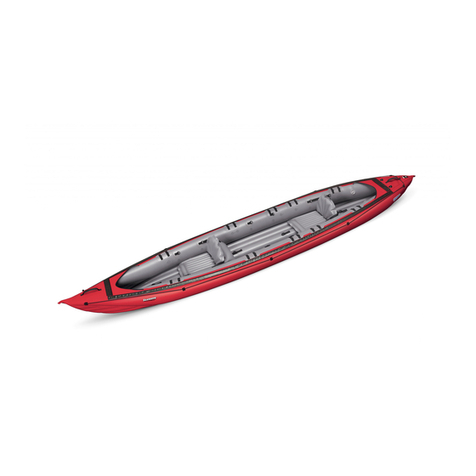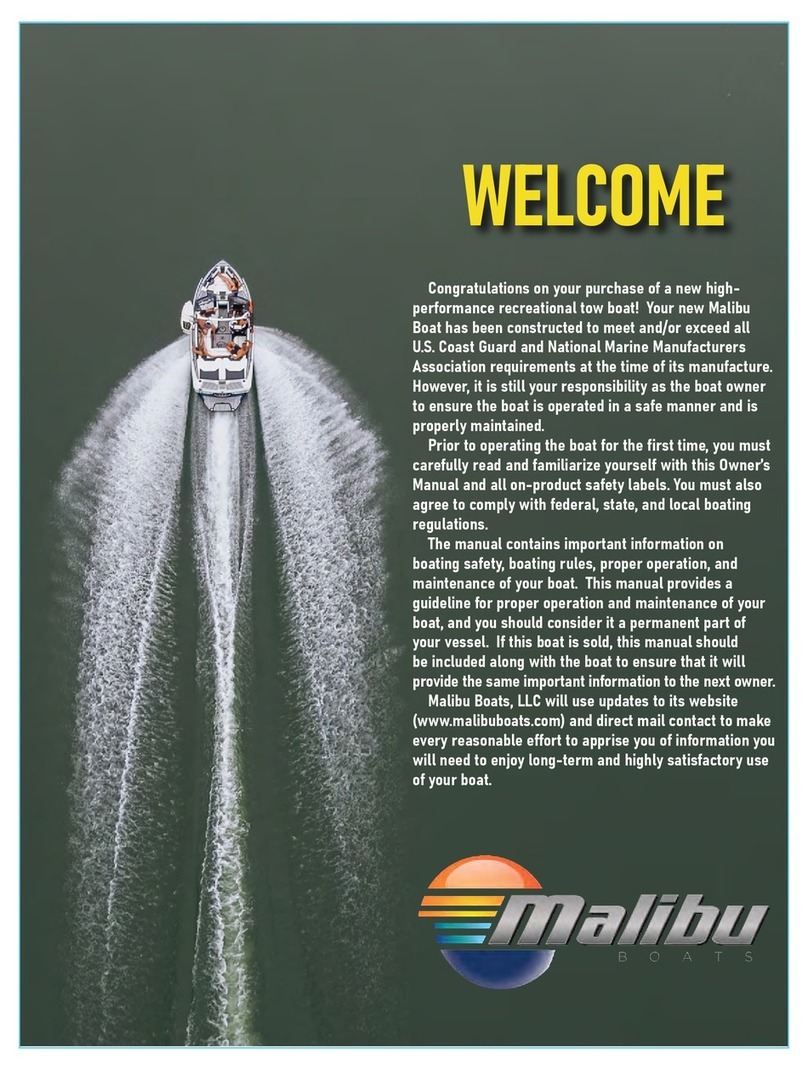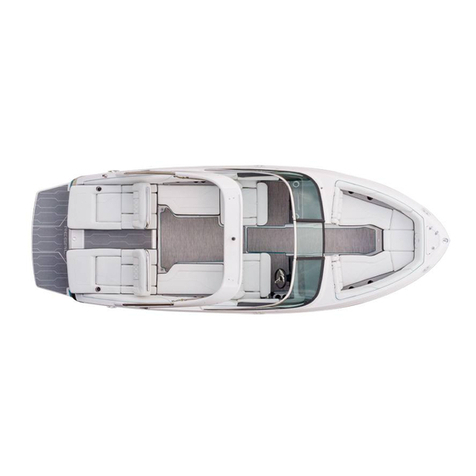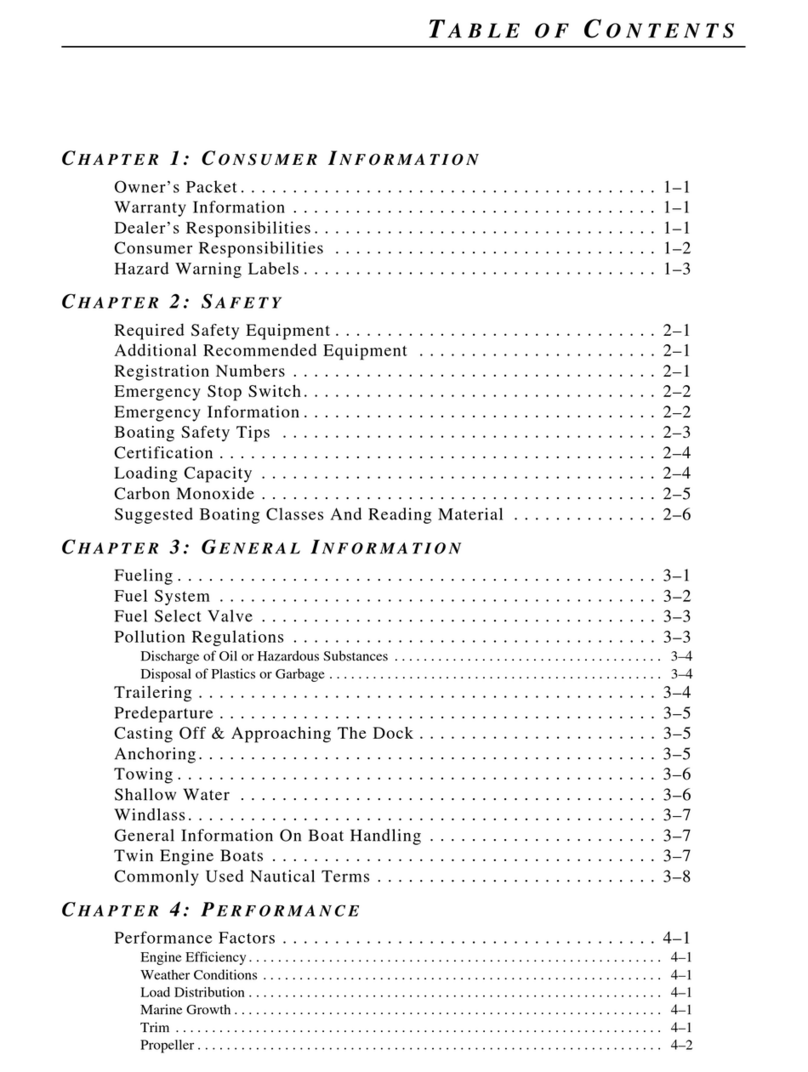Tayana 37 Manual

Chapter I
OPERATIONS
AND
MAINTENANCE
MANUAL
Chapter 1

I-1
TAYANA 37
OPERATIONS
AND
MAINTENANCE
MANUAL
Originally prepared by Southern Offshore Yachts.
Converted to digital format by Harvey J. Karten August 1998. Current update: 1/10/02
Many thanks to Ed Potter, Tom Beard and Mauro Migliorelli

I-2
TABLE OF CONTENTS
I. INTRODUCTION .
II. SPECIFICATIONS
II-A. General Design Specifications
II-B. Serial Numbers
II-C. Materials
II-D. Construction
II-E. Importer's Documents
II-F. Procedures & Data For Documentation .
III. COMMISSIONING AND DECOMMISSIONING
III-A. Initial Commissioning
III-B. Owner Commissioning
III-C. Decommissioning for Storage
III-D. Recommissioning After Lay-Up
IV. OPERATING PROCEDURES
IV-A. Sailing The Tayana 37 Cutter
IV-B. Sailing The Tayana 37 Ketch
IV-C. Tuning The Spars And Rigging
IV-D. Tuning Under Sail
IV-E. Handling Under Power
IV-F. Fuel System
IV-G. Electrical Systems
IV-H. The Plumbing Systems

I-3
V. MAINTENANCE & MAINTENANCE PROCEDURES
V-A. The Hull
V-B. The Deck And Cabin Top
V-C. Interior Woodwork
V-D. Spars, Rigging, And Sails
V-E. Auxiliary Engines & Related Systems
V-F. Electrical Systems
V-G. Plumbing and Sanitation Systems
LIST OF ILLUSTRATIONS AND TABLES
Drawing
Tayana 37 Cutter Sail Plan
Tayana 37 Ketch Sail Plan
Tayana 37 Deck Plan
Tables
ELECTRICAL SYSTEMS/The Energy Audit System
(Table IV.-1)
ELECTRICAL SYSTEMS/The 12 Volt System
(Electric Wire Number & color Codes-Table V.-1.)
Figure
CONSTRUCTION. Thiokol Joints (Figure II.-l.)
FUEL SYSTEM - (Figure IV.-1.)
FRESH HOT AND COLD WATER SYSTEM - (Figure
IV.-2.)
AUXILIARY ENGINES/Installation
Exhaust And Engine Mounting -(Figure V.-1.)
ELECTRICAL SYSTEMS/The 12 Volt D.C. System
(Figure V.-2.)
PLUMBING AND SANITATION SYSTEMS/Bilge Pumping
Systems - (Figure V.3.)

I-4
ANNEX I ............................................................................................... Winch Assemblies
ANNEX II.............................................................................................. Warranty
ANNEX III ............................................................................................ Miscellaneous Info
PHRF Rating
Rigging (P, I, J and E Values) of Cutter
Fuel Tank Depth vs. Volume

I-5
INTRODUCTION
You are to be congratulated on your selection of the TAYANA 37 cruising yacht. There is
no better yacht in her size range on the market. With care and proper maintenance she will
not only prove to be an excellent investment, she will take you cruising anywhere in the
world safely and comfortably. This is being proven almost daily. Ocean crossings by
TAYANA 37's are routine. Circumnavigations have been reported. By the same token, over
100 of these yachts are the primary homes of their owners.
The object of this handbook is to help you to know your yacht and to guide you in
providing proper care and maintenance. And really, it isn't very hard- in fact, it can be a lot
of fun. Your TAYANA 37 has been designed and built with maintenance in mind.
Machinery, pumps, glands, seacocks, etc. have been installed to insure full and easy access.
Where simplicity and adequate function do not conflict, the simpler equipment has been
chosen. In a few cases, custom interiors have complicated some equipment installations, but
you will find that adequate access and straight-forward installation have alleviated the
potential for problems.
In the various sections which follow, you will find discussions of materials and
construction, hull maintenance, rigging and sails, machinery-electrical systems and
plumbing. But remember, this is a TAYANA 37 manual. It is not a general maintenance
manual. It is not designed to take the place of your manufacturer's equipment manuals. In
fact, should you find conflicts between this manual and that published by the manufacturer
of any piece of equipment, the manufacturer's recommendations should be followed.

I-6

I-7

I-10

I-11
BARIENT WINCH #22
WINCH ASSEMBLY

I-12
Volume in Fuel Tank in Bow of older Tayana 37 as a function of height of fuel in tank. As
the tank is shaped in the form of a polyhedron, the exact relationship of fuel level to total
volume is non-linear and difficult to assess. Based on data provided by Tom Beard in TOG
News.
Fuel Tayana 37 Bow Tank
0
5
10
15
20
25
0 102030405060708090100
Gallons
Depth

II-1
Chapter II SPECIFICATIONS ...............................................................................................II-1
A. General Design Specifications......................................................................................II-1
B. Serial Numbers...............................................................................................................II-2
C. MATERIALS ................................................................................................................II-4
D. CONSTRUCTION........................................................................................................II-5
E. IMPORTER’S DOCUMENTS (No information provided in manual)..........................II-8
F. PROCEDURES AND DATA FOR DOCUMENTATION...........................................II-8
Procedure ........................................................................................................................II-8
Chapter II SPECIFICATIONS
A. General Design Specifications
Length Overall 42' 2"
Length on Deck 36' 8"
Length Waterline 30' 10"
Beam 11' 6"
Draft 5' 8"
Displacement 22,500 lbs. (dry)
Ballast (Internal) 7,340 lbs.
D/L (Displacement/Length) 337
SA/D (Sail Area/Displacement) for Cutter 17.3
B/D (Ballast/Displacement) 33%
Sail Area
Cutter 864 square feet (total)
Main 342 sq. ft.
Jib 292 sq. ft
Staysail 230 sq. ft
Rigging Values:.
I = 51.0 (Length from top of mast to deck) – May vary – confirm on your boat.
J = 19.25 (Length from Forestay to mast )
P = 44.0 (Length of Luff of Mainsail)
E = 15.25 (Length of Boom)
Calculated length of forestay based on I and J values = 54.5'
Approx. area of 110% Genoa = 470 Square Feet
Source of Data: DESIGNER'S SAILPLAN – obtained from SailRite Webpage
PHRF Rating of Tayana 37, Cutter Rig = 180
Ketch 786 square feet (total)
Main 263 sq. ft
Jib 209 sq. ft.
Staysail 156 sq. ft.
Mizzen 140 sq. ft.

II-2
Standard Engine Depending upon year of construction and original owner’s choice:
Perkins 4-108 Diesel or YANMAR 3QM30 Diesel
Fuel Tankage may vary 100 gallons (U.S.)
Water Tankage may vary 100 gallons (U.S.)
Vertical Clearance 55feet (Verify on your particular vessel)
Non-Dimensional Values:
Hull Speed 7.46
Comfort Index 40.78
Capsize Ratio 1.63
Pounds/Inch 1,274
(Pounds per Inch Immersion: The weight required to sink the yacht one inch.
If the boat is in fresh water multiply the result by 0.975. If you know the beam
at the waterline (BWL) multipy the result by BWL/Beam. )
B. Serial Numbers
Hull Number (Coast Guard) _____________________
Engine Serial Number _____________________
Hot Water Heater Serial Number _____________________
Stove Serial Number _____________________
Battery Charger Serial Number _____________________
Stereo Serial Number _____________________

II-3
Polars for Tayana37 Cutter

II-4
C. MATERIALS
A few words about materials are called for because of the many questions people ask
about the quality of the metals, woods, and plastics used in Far East built yachts.
Resins. The resins used in the construction of TAYANA yachts are polyesters
purchased in the United States or Japan. Their quality equals or exceeds that of the
resins used in nearly any U.S. or European building yard. They are not of the fire
retardant type, however. Yachts built from late 1985 use isophthalic gel coats to resist
blistering.
Fiberglass: Fiberglass is generally purchased from the United States although some
Japanese and European glass is used. The primary glass structures are made from 1.5
ounce mat and 24 ounce woven roving.
Core materials. Various core materials are used. If a cored hull has been ordered the
core material is Airex (TM). This plastic material is light and highly resistant to
moisture. It also is an excellent insulator. The decks of TaYang yachts are generally
cored with wood blocks cut into two inch squares and formed into core "mats" much as
Balsa is used. It is heavier than either Balsa or Airex, but it is cheaper than either and
tolerates fastenings better. Where there is to be a heavy installation of some type, such
as a winch or windlass, the core material is usually a solid plywood sheet covered on
both sides by a heavy fiberglass laminate.
Teak. Teak is obtained from several sources. The most common, at this writing, appears
to be Indonesia. The demand for Teak is sufficiently high that properly cured Teak is
virtually impossible to find. It has been reported to us that the Teak obtained by TaYang
is generally two to three years old when purchased. This Teak is then cut into planks and
stored in a drying yard for a period of months. It is dried further in a kiln before it is
used on a yacht. Optimally, Teak would be aged for seven to eight years before use and
kilns would not be used.
Curing cracks have occasionally been a problem in yachts with solid Teak table or desk
tops. Where this has occurred, the tops have been replaced. On the whole, however, the
Teak has been surprisingly good and, in applications such as ceiling and decks, it is
almost problem free.
* SEE SECTION V. FOR PROPER MAINTENANCE CARE.
Plywood Plywood is the core material used in interior bulkheads, soles, and tops as well
as for certain structural applications. TaYang does use marine plywood. The glues used

II-5
between the plys is waterproof. There have been few plywood problems when owner
maintenance has been reasonable.
Stainless Steel Type 304 stainless steel is most common in yachts whether built in the
Far East or elsewhere, and that is what TaYang generally uses. Type 316 stainless steel
is the best for yacht application. but it is considerably more expensive than type 304.
There is little difference in strength between them, but type 304 can tend to show
corrosion which while generally-harmless, is irritating
Bronze Bronze fittings used on TAYANA yachts are made in Taiwan. Tests by an
independent laboratory showed that the bronze used is of good marine alloy and grade.
The bronze castings are C86800 (55Cu, 37Zn, 3Ni, 2Fe, 3Mn alloy while such items as
turnbuckle barrels are C19000 alloy (98-7Cu, 1.1Ni, 0.25P) .
Iron TaYang uses iron in fuel tanks and ballast. This is important because iron is less
susceptible to corrosion than is the mild steel that is occasionally used by some builders
in place of iron. TaYang does paint the iron with a good quality red lead primer to help
extend the life of the tank.
D. CONSTRUCTION
Your TAYANA 37 has been constructed of the finest materials, using the best
techniques, and it exceeds the specifications laid down by any of the most accepted
standard-setting agencies. The fiberglass schedule for the hull is shown in figure II-1.
and Table II.-1. Layup is done in a single mold by hand using polyester resin.
The large female mold is separated longitudinally for cleaning and mold preparation.
The gelcoat is sprayed in and the first glass layer is laid up. The mold is then joined
and all the remaining layups are done in the assembled mold. While the hull is still in
the mold, bulkheads are installed and the hull is allowed to cure. The deck is laid up in
much the same way except that a core of wood is used in those deck areas which will
generally be required to support loads such as decks and cabin top.
Ballast is made of a single casting of Black Iron. The ballast casting is lowered into
the keel cavity and is fully encapsulated to become part of the hull. The deck and hull
are joined by one of the strongest methods in the industry. A diagram of the deck to
hull joint is shown in figure II-1. Assembling the hull and deck is one of the most
critical operations in the yacht's construction. The deck is lifted by a crane above the
hull. The joint is prepared with 5200 epoxy compound and the deck is then-set onto
the hull. The joint is -then bolted together using stainless steel-bolts on varying centers
depending on the curve of the hull at the various points. Once the joining has been
accomplished, the joint is fiberglassed as shown in the figure. The result is a single
piece, extremely strong hull with a rigidly curved hollow beam in the form of a
bulwark running nearly the entire length of the yacht.

II-6
Once these critical operations have been finished to the satisfaction of the company
engineers, exterior trim is installed and the work on the accommodations is
undertaken. A team of the world's finest boat carpenters and finishers takes over the
yacht and frames in the interior cabinets and bunks, as shown on the plans. This work
is done with extreme care and attention to detail. Framing is actually glassed into the
hull and becomes an integral part of it. As a result, the quality and livability of the
accommodations is largely a function of how well the framers do their job. Cabinets,
doors, drawers, and the like are done by cabinet makers in a specialty shop to the order
of the production foremen. TaYang engineers closely supervise every step to insure
that dimensions are met and proper installation is made. The result is a yacht whose
strength and beauty are second to none and whose accommodations precisely fit the
needs of its new owner.
The beautiful spruce spars which come on some TAYANA 37's are made in a special
spar shop located in the factory complex. The spruce used is the finest that can be
found and truly approaches aircraft quality. It is not unusual to see grains, which are
perfectly straight for 20 feet. The spruce planks are carefully scarfed together to make
planks of the proper length and glued into the box shape using epoxy. Wires, conduits
and reinforcements are constructed into the spars as required. Final shaping and
finishing is all done by handy men who have years of experience in building fine
wood spars.
If aluminum spars are to be supplied, these are ordered from overseas suppliers-
Taiwan has no extrusion capability at this writing. Generally, the suppliers have been
ISOMET of France and YACHT SPAR out of New Zealand. ISOMET masts are
received already anodized and cannot be painted. YACHT SPARS are painted at the
yard and the color can be selected by the buyer. TaYang uses a primer and
polyurethane for this. Aluminum spars are also being imported from Japan These are
painted by the spar manufacturer.
Standing rigging is assembled at the yard using Japanese stainless steel cable and
Taiwanese-made turnbuckles and swage end fittings. A crew at the factory sets up the
spars and all of the rigging is fitted to each yacht. This is an important factor in cutting
down the number of modifications which might have to be done in the U.S. Similarly,
pulpit, lifelines, stanchions, and bowsprit are all installed to insure proper fit.
The final step is packing the yacht for shipment. Spars, rigging, and any projecting
assemblies are all disassembled and packed either in the hull, or, in the case of the
masts, into special boxes. On the shipping date, the yacht is loaded onto a lowboy and
taken to the huge port city of Kaohsiung where it is loaded aboard one of the many
container carriers which operate between Taiwan and the United States.

II-7

II-8
E. IMPORTER’S DOCUMENTS (No information provided in manual)
F. PROCEDURES AND DATA FOR DOCUMENTATION
Documentation must be accomplished with the United States Coast Guard in the
United States or with the governing agency in the country where your vessel is to
be registered. We suggest you contact the Documentation office nearest you for full
details, forms, and instructions.
The following notes and references are made for your information and convenience.
They should in no way be misconstrued as complete and detailed instructions:
Procedure
Pleasure Class Under 20 tons requires a Yacht
License. Twenty tons and over
requires a certificate of Enroll-
ment and a Yacht License.
Application for - Requires a Builder's Certificate
Admeasurement issued by the builder on the pre-
scribed Coast Guard form. This
certificate will be retained by
the Coast Guard with certified
copies available to the owner.
Admeasurement The admeasurer uses data in the Builder's
Certificate (BC) to compute net tonnage. The following
formulas are used for sailboats:
Gross Tonnage = 1/2 (LBD/100)
Net Tonnage = 0.9 (Gross Tonnage).
Where: L = Length
B = Breadth
D = Depth
Official Number - After admeasurement files your certificate of tonnage,
application is made for an official number. Title and
mortgage papers are required.
Additional Forms - Applications for number.
Declaration of Ownership and/or

II-9
Extent of interest.
Identification of Owner's or
Existing Mortgages.
Declaration of No Foreign Interest involved.
Declaration of Master of Vessel.
Declaration No freight or Commercial
Passengers to be Carried on Board.
Designated Home Port-Licensing
Office.
Designated Hailing Port-Berth
Marking Certificate
Commercial Class Contact your U.S. Coast Guard Documentation Office for
information- due to the complexity of application.
Table of contents
Other Tayana Boat manuals
